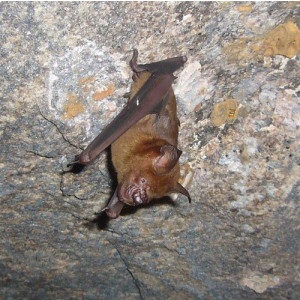Painted Bat Did you see this animal?
Scientific Name : Kerivoula picta
Family : Vespertilionidae
Order : Chiroptera
Class : Mammalia
Phylum : Chordata
Other Name : Painted Woolly Bat
Habitat : Forest, Grassland
Description : Painted bat known for its striking and colorful fur, which sets it apart from many other bat species.
The painted bat is relatively small, with a wingspan of about 25 centimeters and a weight of around 14 grams. Its fur is characterized by a unique pattern of orange, black, and white stripes, which give it a distinct appearance. The wings are long and narrow, allowing the bat to fly quickly and maneuver through dense forests.
Painted bats are found in a variety of habitats, including tropical rainforests, deciduous forests, and mangrove swamps. They prefer areas with plenty of foliage and are often found roosting in the branches of trees.
The painted bat is primarily insectivorous, feeding on a variety of insects including moths, beetles, and flies. It uses echolocation to locate its prey, emitting high-pitched sounds that bounce off objects in its environment and allow it to determine the location, size, and movement of potential food sources.
Painted bats are nocturnal, meaning they are active at night. During the day, they roost in trees or other protected areas, often hanging upside down. They are social animals and are often found roosting in groups.
Painted bats are polygamous, meaning that males mate with multiple females during the breeding season. Breeding usually occurs between January and March, with females giving birth to one or two pups per year. The young are born with their eyes closed and rely on their mothers for food and protection.
Painted bats are fast and agile fliers, able to reach speeds of up to 25 miles per hour. They use their long, narrow wings to make quick turns and fly through dense forest canopies.
Like all bats, painted bats use echolocation to navigate and find food. They emit high-pitched sounds that bounce off objects in their environment, allowing them to determine the location and movement of prey.
Painted bats typically roost in groups of up to 20 individuals, often in the foliage of trees or in other protected areas. They may also use artificial structures such as buildings or bridges for roosting.
The painted bat is not currently considered threatened or endangered. However, like many bat species, it is vulnerable to habitat loss and fragmentation, as well as disturbances caused by human activities such as deforestation and agricultural development. Additionally, painted bats may be preyed upon by owls, hawks, and other predators.
Overall, the painted bat is a fascinating and unique species with many interesting characteristics and behaviors.
The painted bat is relatively small, with a wingspan of about 25 centimeters and a weight of around 14 grams. Its fur is characterized by a unique pattern of orange, black, and white stripes, which give it a distinct appearance. The wings are long and narrow, allowing the bat to fly quickly and maneuver through dense forests.
Painted bats are found in a variety of habitats, including tropical rainforests, deciduous forests, and mangrove swamps. They prefer areas with plenty of foliage and are often found roosting in the branches of trees.
The painted bat is primarily insectivorous, feeding on a variety of insects including moths, beetles, and flies. It uses echolocation to locate its prey, emitting high-pitched sounds that bounce off objects in its environment and allow it to determine the location, size, and movement of potential food sources.
Painted bats are nocturnal, meaning they are active at night. During the day, they roost in trees or other protected areas, often hanging upside down. They are social animals and are often found roosting in groups.
Painted bats are polygamous, meaning that males mate with multiple females during the breeding season. Breeding usually occurs between January and March, with females giving birth to one or two pups per year. The young are born with their eyes closed and rely on their mothers for food and protection.
Painted bats are fast and agile fliers, able to reach speeds of up to 25 miles per hour. They use their long, narrow wings to make quick turns and fly through dense forest canopies.
Like all bats, painted bats use echolocation to navigate and find food. They emit high-pitched sounds that bounce off objects in their environment, allowing them to determine the location and movement of prey.
Painted bats typically roost in groups of up to 20 individuals, often in the foliage of trees or in other protected areas. They may also use artificial structures such as buildings or bridges for roosting.
The painted bat is not currently considered threatened or endangered. However, like many bat species, it is vulnerable to habitat loss and fragmentation, as well as disturbances caused by human activities such as deforestation and agricultural development. Additionally, painted bats may be preyed upon by owls, hawks, and other predators.
Overall, the painted bat is a fascinating and unique species with many interesting characteristics and behaviors.
Distribution in Bangladesh
References:
description written by:Asad U. Tanvir,Department of Zoology,Jagannath University,Dhaka; reviewed by:Muntasir Akash,Department of Zoology,University of Dhaka;Taxonomic Checklist:Red List of Bangladesh Volume 2: Mammals, 2015, IUCN; information sources:Wikipedia , iucnredlist.org; photo credit:Jenis(www.inaturalist.org/people/madhavan1), photo copyright: iNaturalist.more information please contact with us.
description written by:Asad U. Tanvir,Department of Zoology,Jagannath University,Dhaka; reviewed by:Muntasir Akash,Department of Zoology,University of Dhaka;Taxonomic Checklist:Red List of Bangladesh Volume 2: Mammals, 2015, IUCN; information sources:Wikipedia , iucnredlist.org; photo credit:Jenis(www.inaturalist.org/people/madhavan1), photo copyright: iNaturalist.more information please contact with us.







































